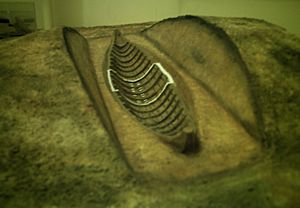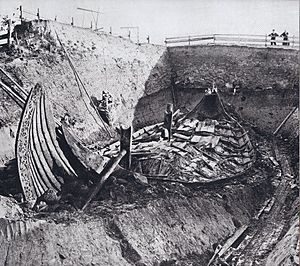Ship burial facts for kids
A ship burial or boat grave is a special way of burying people. It means that a ship or boat is used as the tomb for someone who has died. Sometimes, the person is buried inside the boat with their special belongings, called grave goods. Other times, the boat itself is one of the important items buried with them. If the boat is very small, it's called a boat grave.
This unique way of burying people was used by many cultures that lived near the sea in Asia and Europe. Some of the most famous ship burials were done by the Germanic peoples, especially the Viking Age Norsemen. People in the Philippines also practiced ship burials long ago, as described in old writings from the 15th century.
Ship Burials in Asia and the Pacific
East Asian Ship Burials
China's Ancient Boat Burials
The ancient Bo people lived in parts of Sichuan and Yunnan province in China. They were known for their special hanging coffins.
The Bo people had a unique burial tradition. Instead of burying people in the ground, they hung coffins on cliffs! These coffins were also shaped like boats. Inside these boat-shaped coffins, archaeologists found interesting items. These included blue and white porcelain bowls from the Ming dynasty, iron knives, and iron spear points. The Bo people disappeared later in the Ming dynasty. You can still see pictures of their daily life on the cliffs where they left their coffins.
In Sichuan, several boat-shaped coffins have been found. They are from the Eastern Zhou Period (770–255 BC). These tombs also held many special objects used in rituals.
Japan's Boat-Shaped Coffins
A boat-shaped coffin was discovered in Japan during construction in Kita Ward, Nagoya. This coffin was older than any other found in Japan before. Another boat-shaped coffin was found in the tomb of the Ohoburo Minami Kofun-gun in Northern Kyoto. This one dates back to the Yayoi Period (4 BC–4 AD). This tomb contained items like a cobalt blue glass bangle, an iron bangle, and several iron swords.
Boat-shaped coffins called haniwa were more common during the Kofun period. These coffins were even shown in paintings with symbols of the sun, moon, and stars. This shows that boats were important symbols in Japan's burial rituals too.
Southeast Asian Ship Burials
Philippines' Boat Graves
Many burial sites in the Philippines include boat burials or graves shaped like boats. Even today, some coffins in the Philippines look like canoes made from hollowed-out logs. Two famous burial sites are found in Batanes and Catanauan.
In Batanes, the burial markers look like boats with clear bows (front) and sterns (back). These markers were made from stone and shaped like the traditional tataya boat. Researchers found that these markers faced Northwest-Southeast. The bow of the markers pointed towards the sea. Interestingly, when storms stopped, the boat markers seemed to line up with the Milky Way Galaxy. This suggests that these burials might have been made to connect with the stars. People believed the boats would carry the dead to the heavens.
About 1500 kilometers from Batanes, another boat-shaped burial site is on Tuhian beach in Catanauan, Quezon. The boats in Catanauan also face Northwest-Southeast, with the bow pointing to the sea. The main difference is that the Batanes markers were made of andesite and limestone. The Catanauan markers were made of coral slabs. Also, the Batanes markers held one burial, while the Catanauan ones held many.
The way these burial sites were lined up shows that people from both places believed in an afterlife. They thought boats could carry souls to the heavens and stars. This idea of boats as a way to the afterlife is found in many cultures around the world.
In the 16th century, Spanish visitors saw a burial site in Bohol. One story tells how people would kill slaves and bury them with their masters. This was so the slaves could serve them in the afterlife. Sometimes, a ship would be loaded with over sixty slaves, food, and drink. The dead person would be placed on board, and the whole ship, with the living slaves, would be buried in the earth.
Perhaps the most famous boat-shaped burial in the Philippines is the Manunggul Jar. This jar was found in a Neolithic burial site in Manunggul cave at Palawan. The jar dates back to 890–710 BC. The most special part of the Manunggul jar is its lid. It has two human figures sitting on a boat. These figures show the soul's journey to the afterlife, with one figure acting as the oarsman.
The jar's lid, with its "ship-of-the-dead," is truly special in Southeast Asia. It shows a clear link between ancient times and today's customs. The boatman is steering the boat, not paddling. Both figures seem to wear bands on their heads and under their jaws. This is still seen in burial practices among native people in the Southern Philippines. The way the front figure's hands are folded across the chest is also a common way to arrange a body on the islands.
The carved front (prow) and eye design of the spirit boat are still found on traditional boats in the Sulu Archipelago, Borneo, and Malaysia. The way the ears, eyes, nose, and mouth are made on the figures is similar to wood carvings seen today in Taiwan, the Philippines, and other parts of Southeast Asia.
Vietnam's Boat Coffins
The Dong Son culture in Vietnam is famous for its many boat-shaped coffins. Archaeologists have found 171 boat-shaped coffins from 44 sites in Vietnam. Most of these were from Dong Son sites. Some burials included carefully placed grave goods inside the coffin with the body. These coffins were often found near water, like rivers or small sea streams.
Ship Burials in Europe
An interesting story about a 10th-century ship burial comes from an Arab traveler named Ibn Fadlan. He saw a ship burial among the Volga Vikings. In 2018, the largest Viking ship grave was found in Norway. It was about 65 feet (20 meters) long. Experts believe it was buried over 1000 years ago for an important Viking king or queen.
Northern European Ship Burials
- Ladby – Found in Kerteminde on the island of Funen, Denmark.
- Gokstad – Found at Kongshaugen in Vestfold, Norway.
- Oseberg – Found at Oseberg farm near Tønsberg in Vestfold, Norway.
- Tune – Found at Haugen farm on Rolvsøy in Tune, Østfold, Norway.
- Gjellestad – Found at a farm of the same name in Halden municipality, Norway. Digging is still happening there as of June 2020.
British Isles Ship Burials

- Snape – An Anglo-Saxon burial from Snape Common in Suffolk.
- Sutton Hoo – A famous Anglo-Saxon burial site near Woodbridge, Suffolk.
- Balladoole and Knock y Doonee – Viking burials found on the Isle of Man.
- Port an Eilean Mhòir – This is the only Viking ship burial found on mainland Britain so far. The mound was discovered in 2006 and dug up in 2011.
- The Scar boat burial – A Viking burial found on Sanday, one of the Orkney Islands.
Baltic Countries Ship Burials
- Salme ships – Found on the island of Saaremaa, Estonia.
Eastern European Ship Burials
- Rurikovo Gorodishche – Located on an island in the Volkhov River near Veliky Novgorod, Russia.
- Sarskoye Gorodishche – From a medieval fortified settlement in Yaroslavl Oblast, Russia.
- Timerevo – From a site near the village of Bolshoe Timeryovo, Yaroslavl, Russia.
- Black Grave – From the largest burial mound in Chernihiv, Ukraine.
Western European Ship Burials
- Solleveld – South of The Hague in the Netherlands. This is the only boat grave found in the Netherlands, dating to the late sixth century.
- Fallward – North of Bremerhaven, Germany. From the fifth century.
- Groix – An island in the south of Brittany, France. From the tenth century.
|
See also
- Ímar Ua Donnubáin, a legendary Irish sailor with some Norse family history
- Stone ship
- Tombs of boat-shaped coffins
- Chariot burial (an Iron Age tradition)
- Solar barge (a Bronze Age tradition)
- Khufu ship (from Ancient Egypt)



